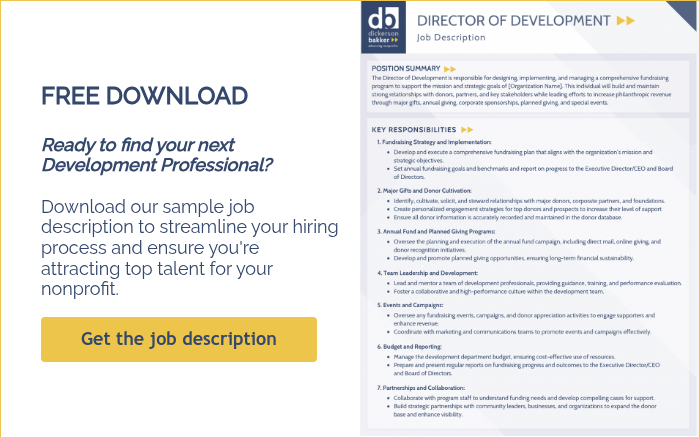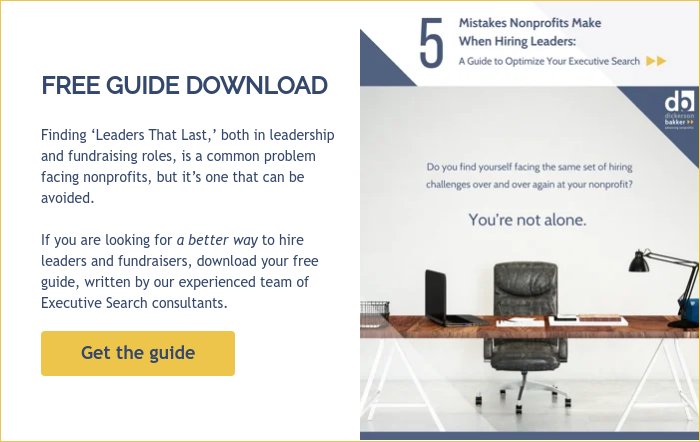Hiring the right people is one of the most important decisions a nonprofit can make, but it’s also one of the most challenging. Between tight budgets, limited HR support, and the need for mission alignment, nonprofits often find themselves struggling to attract and retain top talent.
Let's explore practical strategies to help you strengthen your hiring practices, so you can build a team that’s not only qualified but deeply committed to your cause.
Common Issues We See with Hiring Practices
Many nonprofits face unique hiring challenges that can hinder their ability to build strong, sustainable teams. Limited resources, urgent staffing needs, and a focus on mission over process can lead to inconsistent or ineffective hiring practices. These issues can result in high turnover, poor job fit, and stalled organizational growth. Some of the most common problems include:
-
Lack of a structured hiring process: Roles are sometimes filled reactively without a clear plan or criteria.
-
Vague or unrealistic job descriptions: Job postings often combine multiple roles or lack clarity, discouraging strong candidates.
-
Limited recruitment reach: Nonprofits may rely too heavily on word-of-mouth or free job boards, limiting diversity and talent pools.
-
Failure to assess for mission alignment: Candidates may have the right skills but not the right values or passion for the cause.
-
Inadequate onboarding: New hires often receive minimal training or support, making it hard for them to succeed or stay long term.
Addressing these pitfalls is the first step toward building a more effective and mission-driven team.
Six Ways You Can Strengthen Your Hiring Practices
Improving your nonprofit's hiring process requires a multi-faceted approach. Here are six key strategies:
Crafting a Compelling Job Description
A compelling job description does more than list duties, it sets the tone for your entire hiring process. For nonprofits, it’s a critical opportunity to communicate your mission, values, and workplace culture while clearly outlining the expectations of the role. A well-written job description helps attract candidates who are not only qualified but also inspired by your cause. It also reduces the chances of mismatched expectations by providing clarity around responsibilities, goals, and required qualifications from the start.
To strengthen your hiring practices, ensure your job descriptions are specific, transparent, and engaging. Avoid vague language and try not to overload the role with unrealistic expectations. Instead, highlight how the position contributes to your organization’s impact and what success looks like in the role. Including a salary range and benefits also signals transparency and respect for candidates’ time. The more thoughtfully crafted your job description is, the more likely you are to attract passionate, high-quality applicants who are a strong fit for your team.
Leveraging Networks and Partnerships
Instead of relying solely on traditional job postings, tapping into professional networks, peer organizations, board member connections, and community groups can open doors to a wider, more diverse talent pool. These relationships can lead to personal referrals, often some of the most reliable hires, as well as shared visibility through co-hosted job fairs, newsletters, or nonprofit alliances.Partnerships with universities, workforce development programs, and mission-aligned corporations can also be instrumental in building a pipeline of potential talent. For example, working with a local university’s nonprofit management program might connect you with enthusiastic graduates looking to break into the field. By making hiring a more collaborative and community-based effort, your organization can both strengthen its internal capacity and deepen its external impact.
Implementing a Structured Interview Process
A structured interview process helps nonprofits make more consistent, equitable, and informed hiring decisions. When interview questions are planned and standardized across all candidates, it becomes easier to compare responses objectively and minimize unconscious bias. This ensures that each candidate is evaluated based on the same criteria, rather than relying on gut feelings or informal conversations. For nonprofits where every hire can significantly impact team dynamics and mission delivery, structure adds a layer of clarity and fairness that improves long-term outcomes.
Beyond fairness, structured interviews also create a more professional and positive experience for candidates. When interviewers are aligned on the role’s requirements and know what to look for, they’re better equipped to ask meaningful, mission-aligned questions and give candidates a clearer picture of expectations.
It also encourages interviewers to look beyond resumes and assess real-world competencies—like adaptability, collaboration, or values alignment—which are critical in your line of work. With a consistent process in place, hiring teams are more likely to select the right person for the right reasons.
Fostering a Mission-Driven Culture
Fostering a mission-driven culture is one of the most effective ways to attract and retain talent in the nonprofit sector. When your organization consistently communicates its values, impact, and purpose (not just externally, but internally), it helps draw in candidates who are genuinely passionate about your cause.
A strong work culture signals to potential hires that this is more than just a job. It’s a community working toward meaningful change. It also gives current employees a deeper sense of purpose, which in turn creates a more positive and engaged work environment. This alignment between values and workplace culture can be a powerful differentiator, especially when competing with the private sector for top talent.
Onboarding for Long-Term Success
Onboarding isn’t just about getting new hires up to speed. It’s about setting them up for long-term success. In the nonprofit sector, where roles are often fast-paced and resource-constrained, a thoughtful onboarding process can make the difference between a thriving employee and one who quickly burns out. Effective onboarding provides clarity around responsibilities, introduces new staff to the organization's mission and culture, and equips them with the tools and relationships they need to succeed. It’s also a critical opportunity to build early momentum and reinforce the value of the work they’ve joined to do.When nonprofits invest in structured, supportive onboarding, they help reduce turnover, boost employee engagement, and improve performance from the start. This might include regular check-ins during the first 90 days, mentorship or buddy systems, and access to training on systems, policies, and expectations. New employees who feel welcomed, informed, and connected to the mission are far more likely to stay and contribute meaningfully over time. In short, onboarding isn’t just the end of the hiring process—it’s the beginning of long-term retention and impact.
Work with a Recruitment Agency
Partnering with a recruitment agency can significantly strengthen a nonprofit’s hiring practices, especially when internal HR resources are limited. These agencies bring expertise, structure, and efficiency to the search process, helping nonprofits find candidates who not only meet the technical requirements of a role but also align with the organization’s mission and culture. A good recruitment partner will help refine job descriptions, expand your reach to passive candidates, and ensure that hiring decisions are backed by data and proven strategies, not just intuition.
For nonprofits looking for a partner who truly understands the sector, DickersonBakker is a valuable option to consider. With decades of experience serving nonprofit organizations, we offer specialized talent solutions tailored to the nonprofit world. Our talent solutions team understands the unique challenges nonprofits face, like budget constraints, mission alignment, and long-term impact, and works closely with organizations to find the right people for the right roles.
Additional Considerations When Hiring for Your Nonprofit
When hiring for a nonprofit, it’s important to look beyond resumes and technical qualifications. While skills and experience matter, equally important are the values, mindset, and motivations a candidate brings to the table. Nonprofit roles often require resilience, creativity, and a strong connection to the organization’s mission—qualities that aren’t always obvious on paper. As you evaluate candidates, keep the following considerations in mind:
-
Cultural fit and team dynamics: Will the candidate thrive in your organization’s unique environment?
-
Passion for the mission: Do they demonstrate a genuine interest in and commitment to your cause?
-
Adaptability and problem-solving: Can they navigate resource limitations and think creatively under pressure?
-
Awareness of sector-specific challenges: Are they prepared for the pace, expectations, and budget realities of nonprofit work?
-
Retention and well-being: Do you have a plan to support this person long-term and help prevent burnout?
Taking a holistic approach to hiring ensures you build a team that’s not only capable, but also connected and committed for the long haul.
Ready to Build the Perfect Team for Your Nonprofit?
Strengthening your nonprofit’s hiring practices takes intention, structure, and a deep understanding of what makes your organization, and its people, thrive. From crafting compelling job descriptions to building mission-aligned teams and onboarding for long-term success, each step plays a vital role in creating a workforce that can drive your mission forward.
If you're ready to take your hiring process to the next level, consider partnering with experts who understand the unique challenges of the nonprofit sector. DickersonBakker’s Executive Search offers the specialized support you need to attract, hire, and retain top-tier talent. Contact our team today to build a team that’s ready to make a lasting impact.




